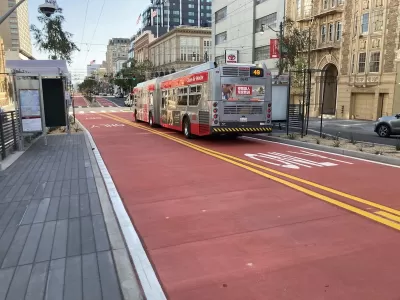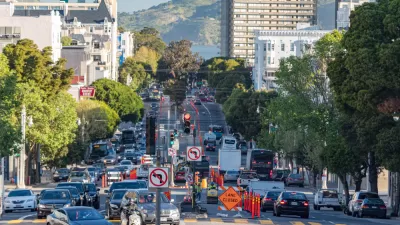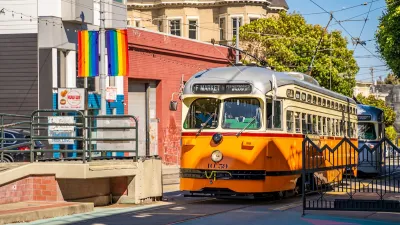The San Francisco rapid bus line is making transit on the corridor more reliable and reducing traffic crashes and congestion.

A Bus rapid transit (BRT) project in San Francisco earned the highest-level designation achieved by U.S. transit projects, Silver, by the Institute for Transportation and Development Policy (ITDP) for its effectiveness in improving transit travel times along the Van Ness corridor.
According to a press release from the city, “The Van Ness project includes dedicated center running transit lanes that don’t get slowed down by parking or turning vehicles, transit signal priority that gives buses the green light as they approach an intersection, as well as low-floor vehicles and all-door boarding, that make it quicker and easier for passengers to load and unload at each stop and fast and frequent operations.”
According to data from the SFMTA, “Bus travel on this corridor is now 36% faster, injury traffic collisions are down by 54%, and transit is 45% more reliable.” The project also added pedestrian bulbouts, countdown signals, and other infrastructure to make walking safer.
Raymone Garner, a Muni Operator of 23 years, said the BRT line “gives us a smoother ride that’s safer with better on-time performance. Riders love it because it’s easier for us to get into the bus zone so it’s easier and safer to pick up passengers, especially people with disabilities.”
The press release adds, “The other BRT Silver-designated projects in the nation include the New Britain Busway in Hartford, Connecticut and the Healthline in Cleveland, Ohio. California has two Bronze projects; the Orange (G) Line in Los Angeles and the sbX E Street Bus BRT in San Bernardino.”
FULL STORY: San Francisco's First Bus Rapid Transit Project Receives Internationally Recognized Designation

Study: Maui’s Plan to Convert Vacation Rentals to Long-Term Housing Could Cause Nearly $1 Billion Economic Loss
The plan would reduce visitor accommodation by 25,% resulting in 1,900 jobs lost.

North Texas Transit Leaders Tout Benefits of TOD for Growing Region
At a summit focused on transit-oriented development, policymakers discussed how North Texas’ expanded light rail system can serve as a tool for economic growth.

Why Should We Subsidize Public Transportation?
Many public transit agencies face financial stress due to rising costs, declining fare revenue, and declining subsidies. Transit advocates must provide a strong business case for increasing public transit funding.

How to Make US Trains Faster
Changes to boarding platforms and a switch to electric trains could improve U.S. passenger rail service without the added cost of high-speed rail.

Columbia’s Revitalized ‘Loop’ Is a Hub for Local Entrepreneurs
A focus on small businesses is helping a commercial corridor in Columbia, Missouri thrive.

Invasive Insect Threatens Minnesota’s Ash Forests
The Emerald Ash Borer is a rapidly spreading invasive pest threatening Minnesota’s ash trees, and homeowners are encouraged to plant diverse replacement species, avoid moving ash firewood, and monitor for signs of infestation.
Urban Design for Planners 1: Software Tools
This six-course series explores essential urban design concepts using open source software and equips planners with the tools they need to participate fully in the urban design process.
Planning for Universal Design
Learn the tools for implementing Universal Design in planning regulations.
Ascent Environmental
Borough of Carlisle
Institute for Housing and Urban Development Studies (IHS)
City of Grandview
Harvard GSD Executive Education
Toledo-Lucas County Plan Commissions
Salt Lake City
NYU Wagner Graduate School of Public Service





























